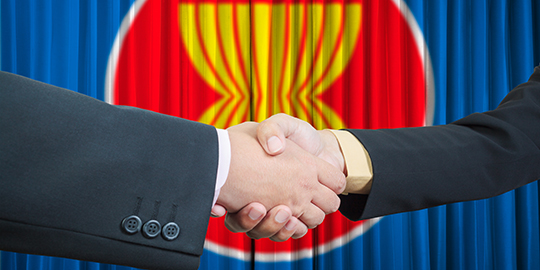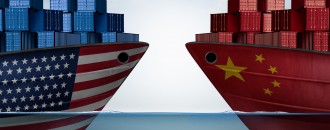
ASEAN & India- A strategic partnership
Prof. A.K. Sen Gupta | The Dollar Business
Introduction The Association of South-East Asian Nations (ASEAN) came into existence on August 8, 1967 in Bangkok, Thailand. The Bangkok declaration (Asian declaration) which emanated from this conclave was signed by a five member group of nations comprising Indonesia, Malaysia, Philippines, Singapore, and Thailand. The Asean group witnessed substantial expansion in subsequent years with countries like Brunei-Darussalam, Viet-Nam, Laos PDR, Cambodia and Myanmar joining the group making it a ten member alliance in the final tally. The Asean declaration had a broad charter of objectives designed to bring all the signatory nations on a closer cooperative mode in varied sectors including economic, social, cultural, scientific, technological and administrative areas. The prime focus was on securing and strengthening the foundations of a prosperous and progressive community of nations with common objectives. The other factor that needs mention was the commitment made by Asean member countries to accelerate the establishment of an ASEAN COMMUNITY based on three pillars, namely the ASEAN Political Security Committee, ASEAN Economic Community, and the ASEAN Socio-Cultural Committee. A blueprint was also drawn up to establish the ASEAN COMMUNITY on a firm footing by providing it legal status with appropriate institutional framework to carry out targeted activities. This article is however confined to the ASEAN agenda in regard to its economic and commercial sectors with particular reference to India’s stakes in its scope of activities.It has been realized that in the years ahead the nations of South-East Asia will carry considerable clout as regards international trade and investment, as markets in the more advanced nations get progressively saturated. This is also in tune with Prime Minister Modi’s “ACT EAST” policy which is now receiving priority status and attention. ASEAN & India India has had a long standing relationship with the ASEAN nations starting with a sectoral dialogue partnership as early as 1992. India became a full-time dialogue partner in December 1995. During the subsequent year, India was invited to act as an active participant in the ASEAN Economic forum. The level of cooperation was stepped up when the first ASEAN-India summit was held in Cambodia in 2001. During this summit, the two entities agreed to fortify relationship in a gamut of activities including human resource development, tourism, culture, scientific& technological research etc. More significantly, the summit laid great emphasis in promoting closer economic relationship between the two regions by promoting trade and investment, facilitating market access and improving the flows of technology by creating suitable information channels. A new high to the ongoing dialogue was seen in 2012 when an ASEAN- India Commemorative summit was held in New Delhi. It was during this summit that the leaders of the respective delegations adopted the ASEAN-India Vision Statement and the partnership between the two escalated to what was then termed as a “Strategic Partnership” where the emphasis was on increased cooperation in varied sectors as opposed to competition. A free trade area (FTA) has also been created between the two regions during the on- going dialogue process. Considered as one of the largest among the global FTA’s with a market of about 1.8 billion people with a combined GDP of US $ 2.8 trillion, the ASIAN-Indian FTA will witness a tariff liberalization of over 90% for products traded between the two regions which would include items like palm oil, coffee, black tea and pepper. Tariffs for over 4000 product-lines are also slated to be eliminated by 2016. In the meantime, a free- trade agreement in the fields of services and liberalization of investment measures has also been initiated.This should stand to India’s advantage which is considered to have its core strength in its varied and competent services sector. Trade &Investment: - Despite the growing co-operation between India and ASEAN over the years, the volumes of trade and investment between the two regions has been below par, considering the true potential that exist between the emerging partners. It is reported that total trade between India and the ASEAN countries showed a sharp decline from $71.8 billion in 2012 to $67.9 billion in 2013. Foreign direct investments (FDI) from India also seems to have witnessed a fall by nearly 41% from$2.2 billion in 2012 to $1.3billion in the subsequent year as per available information. Total Foreign Direct Investment inflows into the ASEAN region as reported amounted to $122.4 billion in 2013, in which $21.32 billion is stated to have come from investments from within the ASEAN region itself. The reasons for the lower volumes of trade and investments between India and its ASEAN partner are not far to seek. During 2013, intra-ASEAN trade which has top priority for the ASEAN alliance stood at an impressive $608.6 billion rising from a base of $458.1 billion in 2008, when the ASEAN Economic Community blueprint was implemented. Major trading partners for the ASEAN region have also traditionally been the developed markets like USA, Japan and European community which account for a significant share of its export-import cake. However, the situation could very well see a change in the overall trading scenario in the near future, with growing emphasis among the group now being accorded to promoting trade and investment among the Asian nations, in strategic partnership with large and promising markets like India and China. Major commodities which currently feature in India’s exports to ASEAN region include petroleum products, transport equipment, machinery and equipment, meat and meat products ,gems and jewelry, dyes and intermediates, electronic goods, pharmaceuticals and marine products. Indian imports from the ASEAN region include vegetable oils, coal, organic chemicals, ores and metal scrap, wood and wood product, transport equipment, coke and briquettes etc. India’s exports to ASEAN in 2011-2012 stood at $30.46 billion while its imports from the region was reckoned at $48.91 billion in the same period showing a trade deficit of $18.45 billion which need to be addressed with suitable strategies. Conclusions India’s economic and commercial relations with the ASEAN region is destined to travel on a high growth path in the coming years. The influential leadership of both regions have escalated their relationship from formal dialogues to a “strategic partnership phase” to provide the required impetus to increased economic and commercial activities in which foreign trade and investment will play a major part. This is in keeping with the new government “Act East Policy” of reaching out effectively to prominent trading entities in the Asian zone. The signing of the free trade agreements on trade in services and speeding up investments should go a long way in addressing the current imbalances in the two way trade. India’s has a recognized competence and a core strength in services trade and the captains of Indian industry have been able to identify some of the major areas wherein foreign direct investments could benefit both regions. The Associated Chambers of Commerce and Industry of India (Assocham) for instance, had mentioned that tremendous opportunities for collaboration exist between India and ASEAN region in specific sectors like IT, Infrastructure, healthcare , pharmaceuticals, financial services, agro-business ,food processing, telecom ,education , hospitality industry, mining, and oil and gas downstream industries to mention a few. The current target of achieving a total trade turnover of $100 billion between the two partners by the end of 2015 is not unrealistic in that context.The ambitious target of $200 billion of total trade envisaged by the next decade could well be attained with the progressive steps initiated and areas of cooperation identified. Select references: 1. Overview- by ASEAN Secretariat at Jakarta,Indonesia, official website 2. Association of South -East Asian nations. Wikipedia -Free encyclopedia - https//en.wikipedia.org 3. ASEAN- India Dialogue relations. Based on note contained in official website of ASEAN Secretariat, Jakarta, Indonesia. 4. Annual Report 2012-2013- Department of Commerce, Ministry of Commerce &Industry. Government of India -"Commercial Relations,Trade Agreements and International Trade Organizations. 5. India-ASEAN Services, Investment, FTA to be in force from July 15, 2015 - The Economic Times- Jan 15, 2015. 6. India signs FTA in Services, Investments with ASEAN - The Indian Express, September 9, 2014. 7. Target $125 billion India -ASEAN Trade by 2015 - Speech of Chairman, India- ASEAN Business Promotion Council,and Assocham- PTI Press release on October 29, 2013.
August 05, 2015 | 5:56 pm IST





 to success.
to success.